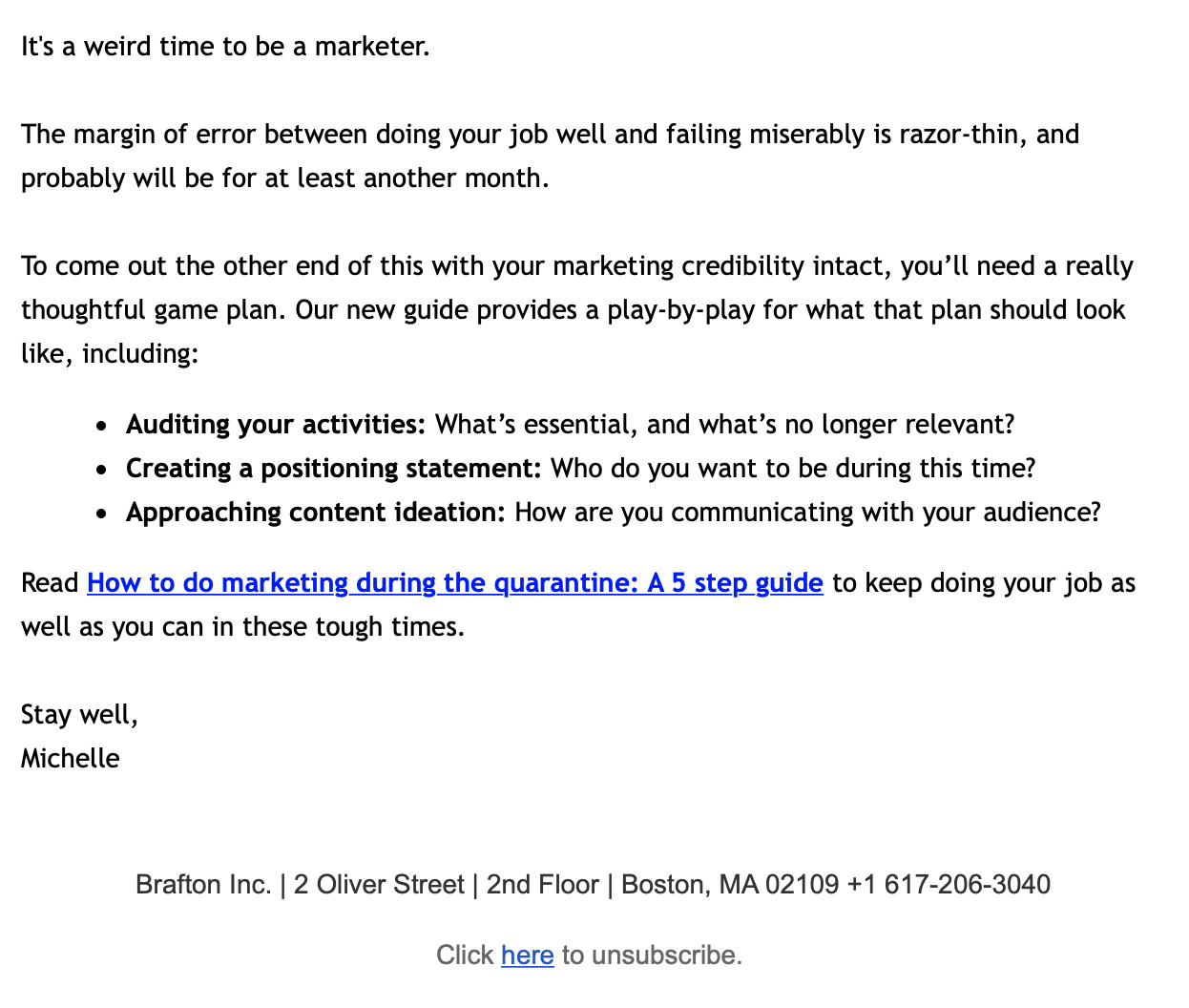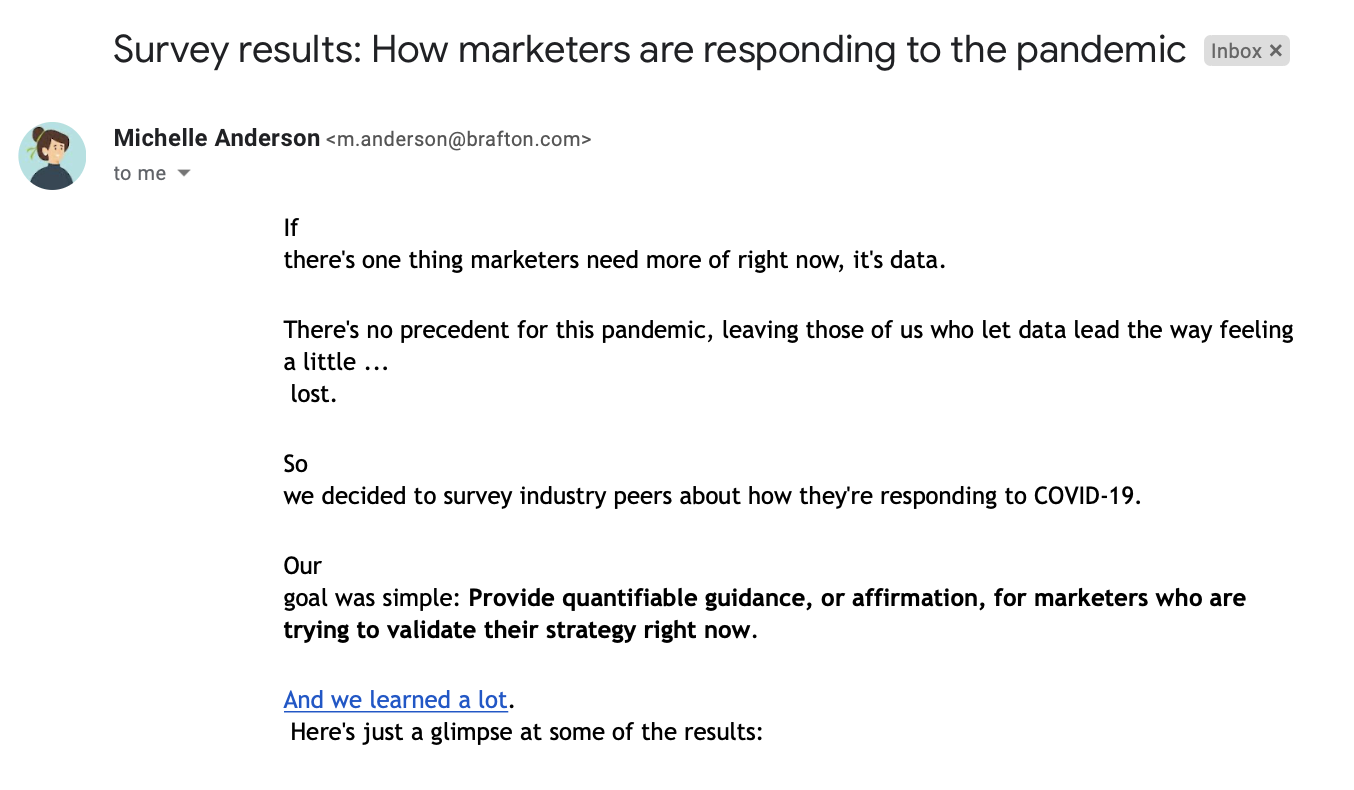A lot of things are up in the air right now, and probably will be through Q2, and possibly into Q3.
But like Celine Dion’s heart, marketing will go on.
Within the next few months, content creators must continue to be relevant and useful to their audiences. Maintaining engagement is crucial, even if lead generation and sales are slumping.
With that in mind, we anticipate these content types to have the greatest value between now and early Q3:
1. Email content
Starting conversations with leads is hard right now because people very much have their priorities in order.
The benefit of email is that it can be personalized to people and their priorities. Marketing automation lets you target your messaging based on different audience segments and the type of content they might actually find useful. It’s not a guaranteed icebreaker, but if you haven’t already segmented your database of contacts into lists, now is a good time to start. It could help you get the right content to the right audience.
A word of advice, though: Inboxes are somewhat saturated. Our own survey data indicated as much, with email being the top-used lockdown-era marketing channel.
Make sure you’re adhering to a few best practices to cut through the noise:
- Take a genuine, warm tone in your messages. Avoid canned, insincere phrases that your audience has heard a million times (“hope you’re doing well” and “we thought this might interest you”).
- Continue providing updates to customers, including steps you’re taking to maintain service levels, and any unfolding operational updates.
- Avoid using “coronavirus” and “COVID-19” in the subject line. Also, use terms like pandemic, quarantine, lockdown and “new normal” sparingly, as everyone’s a bit fed up with the constant reminders.
- Try to focus on a message of resilience and moving forward (e.g., this is our reality, now here’s what to do about it).
- Don’t send sales pitches to companies that are hard hit by the pandemic.
Here’s an example of an email we sent out that was well received, with a subject line of “A guide to thoughtful marketing during a crisis”:

2. Blog posts and infographics
Useful information is always welcome, especially when it doesn’t require you to fill out a contact form. It can still be worthwhile to create evergreen gated assets that you can save for when the market rebounds (assuming you have the time).
But if your marketing operation is lean right now, prioritize ungated content.
Start by trying to treat your blog like a living, breathing FAQ feed.
For instance, our account managers and salespeople started getting questions about how to respond to the fact that they won’t have another trade show for the rest of Q2. In response, we created a blog post about ideas for redirecting that spend to keep up.
Infographics are also useful right now, and they don’t necessarily have to be at all related to COVID-19.
As long as they’re interesting and useful, they still have value.
For instance, an infographic we created in 2019 about marketing spend statistics has generated more than 700 unique user sessions this past week:

That pales in comparison to our top-performing piece, which is about content marketing during quarantine, but it’s still in the top 10, which shows us that people still have an appetite for data, especially when that data is visually conveyed.
One other thing about non-gated assets: If users like what they see, they’re that much more likely to sign up for your newsletters.
3. Interactive content (surveys, webinars, forms, etc.)
People are spending more time online than usual right now because there isn’t much else to do.
But you still have to earn their attention, and interactive content can pull in a lot of eyes.
One of the cleverest examples of this is an ambient office sound generator developed by Kids Creative Agency. It lets you add your number of colleagues and click on different office fixtures to loop your preferred white noise.

Your brand doesn’t necessarily have to create a new interactive webpage. There are plenty of more immediate ways to interact with your target audience in the coming weeks:
- Surveys: There isn’t a whole lot of data to support, guide, or affirm business decisions right now. Create surveys with questions that you wish there was more data on, distribute it and use that information to create helpful content.
- Webinars and free-form video conferences: Webinars are like virtual keynote presentations; they were practically made for this situation. And if you’re going for something a little more informal, try tapping your email lists for leads who might be interested in a more free-form conference. Think of it as a video workshop where you lend your expertise to your target audience for 30 minutes by answering questions they have.
- User-generated content: There is a lot you can do with user-generated content right now: create a corporate promo that shows some of the faces of your company working from home; encourage your followers to post their productivity hacks to social media during this time; or you can even take user-generated video content and turn it into an ad, as ADT did:
Your company may be distant from its audience and customers right now, but it can still be social.
Focus on ways to start virtual conversations within the next few months.
Keep an open mind going forward
Any idea you have right now for how you can connect with your audience is worth exploring.
We realize a lot of people want to play things safe, and even our marketing team has scaled back a few projects.
But the world is operating under a very different set of circumstances now than it was a month ago, and we can only really guess at how much longer our current way of life will go on for.
So between now and Q3, focus on how to be a marketer in our current normal – not the one that you wish would come back.
That may mean venturing out of your comfort zone or doing things that don’t feel like they have immediate returns. And folks, you might get a few things wrong. Case in point: To help in a pinch, I uploaded an email that my colleague Michelle created to Marketo, and this happened:

But until we’re back to business as usual, we’ll have to table marketing as usual, and that may mean trying new things.
And if nothing else, a lot of us will walk away better, more experienced and far more versatile marketers.





